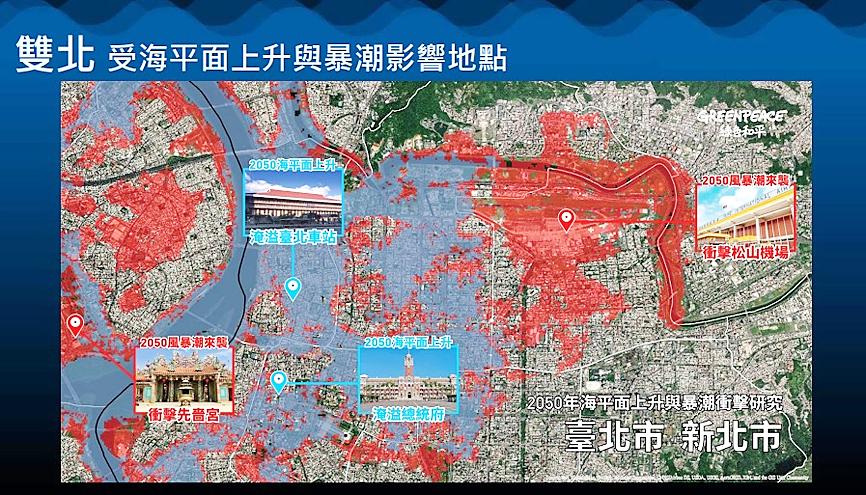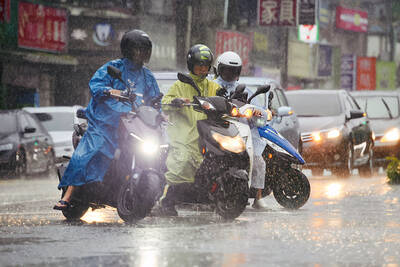If Taiwan fails to curb its carbon dioxide emissions over the next 30 years, rising sea levels and storm surges would pose a threat to millions of residents in the six special municipalities, Greenpeace Taiwan said yesterday as it urged the central and local governments to take action.
The call came as the environmental group released a report on its analysis of the problems that Taiwan could face as the global sea level rises, warning that the seas around Taiwan are rising at twice the global average due to the nation’s location and influence from ocean currents.
Greenpeace climate and energy campaign director Lena Chang (張皪心) told a news conference in Taipei that the analysis showed that global warming has the potential to severely affect Taiwan, but it is not just the central government that needs to take action, but also the mayors of the six cities.

Photo courtesy of Greenpeace Taiwan
The special municipalities account for more than 70 percent of Taiwan’s population, “so their mayors have a responsibility to protect their residents’ lives and property from threats,” she said.
Typhoons and tropical storms would cause sea levels to rise further, and strong winds brought by such systems can cause storm surges, in which seawater flows inland, the report said.
Taiwan suffered storm surge damage during Typhoon Dujuan in 2015 and Typhoon Megi in 2016, which led to flooding in multiple locations across the nation, it added.
Citing sea-level research conducted by the US-based non-profit organization Climate Central, the report said 1,398km2 of Taiwan’s land mass would be inundated by seawater if no aggressive action is taken to curb carbon emissions before 2050.
This could affect 1.2 million people, while storm surges could expand the risk to more than 2.9 million residents in the special municipalities and swamp 2,120km2 of land, it said.
The affected building areas would be about the size of 500 Taipei Arenas, it added.
Simulations showed that the Presidential Office Building, Taipei International Airport (Songshan airport), Taipei Railway Station and the Taipei Children’s Amusement Park would be flooded, while Taichung’s Gaomei Wetlands and Mitsui Outlet in the Port of Taichung would bear the brunt of the flooding damage, the report said.
Tainan would see the worst damage, with floodwater submerging historic sites such as Fort Zealandia and the Sicao Fortress, it said.
Tourist attractions in Kaohsiung such as the Pier-2 Art Center, 85 Sky Tower and Kaohsiung Formosa Boulevard MRT Station would also be flooded, it said.
Mayors of the six municipalities should conduct comprehensive assessments on the climate risks that their cities could face, “such as identifying transportation hubs, historic sites and infrastructure that are most susceptible to climate change and planning city development accordingly,” the report said.
They should set carbon-cutting goals and ways to achieve them, including medium and long-term goals to develop renewable energy and a timeline to retire gasoline-powered motor vehicles, it added.
Additional reporting by staff writer

The combined effect of the monsoon, the outer rim of Typhoon Fengshen and a low-pressure system is expected to bring significant rainfall this week to various parts of the nation, the Central Weather Administration (CWA) said. The heaviest rain is expected to occur today and tomorrow, with torrential rain expected in Keelung’s north coast, Yilan and the mountainous regions of Taipei and New Taipei City, the CWA said. Rivers could rise rapidly, and residents should stay away from riverbanks and avoid going to the mountains or engaging in water activities, it said. Scattered showers are expected today in central and

COOPERATION: Taiwan is aligning closely with US strategic objectives on various matters, including China’s rare earths restrictions, the Ministry of Foreign Affairs said Taiwan could deal with China’s tightened export controls on rare earth metals by turning to “urban mining,” a researcher said yesterday. Rare earth metals, which are used in semiconductors and other electronic components, could be recovered from industrial or electronic waste to reduce reliance on imports, National Cheng Kung University Department of Resources Engineering professor Lee Cheng-han (李政翰) said. Despite their name, rare earth elements are not actually rare — their abundance in the Earth’s crust is relatively high, but they are dispersed, making extraction and refining energy-intensive and environmentally damaging, he said, adding that many countries have opted to

People can preregister to receive their NT$10,000 (US$325) cash distributed from the central government on Nov. 5 after President William Lai (賴清德) yesterday signed the Special Budget for Strengthening Economic, Social and National Security Resilience, the Executive Yuan told a news conference last night. The special budget, passed by the Legislative Yuan on Friday last week with a cash handout budget of NT$236 billion, was officially submitted to the Executive Yuan and the Presidential Office yesterday afternoon. People can register through the official Web site at https://10000.gov.tw to have the funds deposited into their bank accounts, withdraw the funds at automated teller

CONCESSION: A Shin Kong official said that the firm was ‘willing to contribute’ to the nation, as the move would enable Nvidia Crop to build its headquarters in Taiwan Shin Kong Life Insurance Co (新光人壽) yesterday said it would relinquish land-use rights, or known as surface rights, for two plots in Taipei’s Beitou District (北投), paving the way for Nvidia Corp to expand its office footprint in Taiwan. The insurer said it made the decision “in the interest of the nation’s greater good” and would not seek compensation from taxpayers for potential future losses, calling the move a gesture to resolve a months-long impasse among the insurer, the Taipei City Government and the US chip giant. “The decision was made on the condition that the Taipei City Government reimburses the related